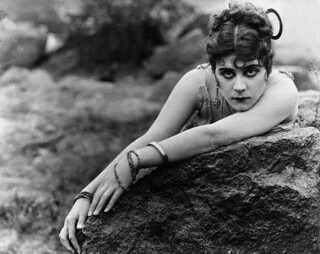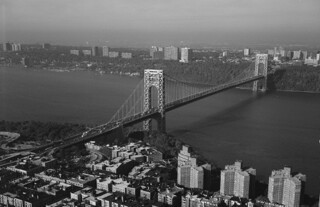Fort Lee
August Kleinzahler
‘One of the most wonderful places you can find anywhere,’ Will Rex wrote in Picture Play in April 1916, ‘is Fort Lee, that magic New Jersey town across the Hudson from New York City where murders, robbers and Indian chases take place while the police force – his name is Pat – leans, yawningly, against a convenient lamp post.’
Fort Lee has been much in the news of late because of Bridgegate and the apparent villainy on the part of Governor Chris Christie’s office, blocking traffic on the George Washington Bridge for a few days to settle the score with local Fort Lee politicians who refused to fall into line. It was home to even more theatrics a century or so ago when it was, briefly, between 1907 and the First World War, the movie capital of America.
Some clever chap across the river in Manhattan, espying the lofty, heavily wooded cliffs of the Palisades rising steeply from the Hudson, thought that the area might be well-suited for Wild West and out-of-doors film scenes. A local hotel called the Rambo, on 1st Street, became the hub of the fledging film industry on the western shore, where film crews and actors hung out, got into costume or enjoyed a beer. The Rambo’s exterior was intermittently dressed up to approximate an authentic Western saloon.
The Edison Studio shot Rescued from an Eagle’s Nest, starring D.W. Griffith in his first important acting role, in 1907 on the cliffs of the Palisades. Seven years earlier, the Broadway actor and local resident Maurice Barrymore had thrown a benefit to build a firehouse on Washington Avenue. His son John, then 18, made his acting debut on that occasion.
Griffith, now turned director, shot The Curtain Pole for Biograph Studio in Fort Lee in 1908. One of the earliest examples of slapstick comedy, the film initiated the career of Mack Sennett, the ‘King of Comedy’.
In 1914, the 20 episodes of The Perils of Pauline, starring Paula Wood, were filmed almost entirely on the cliffs of the Palisades.
Theda Bara, ‘the vamp’, made her debut in 1915 in A Fool There Was. You can find a photograph of me in an Images of America photographic history of Fort Lee, in my capacity as the town’s poet laureate, posing with several other checkered characters at the unveiling of Theda Bara Way a few years ago.
In 1921, the Marx Brothers appeared in their first film, Humor Risk, shot in Fort Lee, but by that point most of the studios had moved west, first to the Arizona desert then to the orange groves of Southern California.
The George Washington Bridge began construction five years later, in 1927, and opened to traffic in 1931. Its towers, rising 600 feet from the Hudson, were originally planned to be clad in concrete faced with granite (the towers of Roebling’s Brooklyn Bridge are solid granite) but the money ran out so the bridge remains in its skeleton form with open-spaced frame and slender steel components, the towers widening only slightly at their bases and with single-arched openings both above and below the roadway. I find it among the most beautiful bridges on earth, more splendid even than the Golden Gate here in San Francisco.


Comments
"Fort Lee was, in those days, a vivid little town, not the usual American suburb … At the north end of town was the George Washington Bridge and just above the bridge a famous hood nightclub called the Riviera, which always booked star entertainers and put on gala floor shows. But it was more famous for its plush gambling casino at the back, the Marine Room, which was off-limits to ordinary patrons. The Marine Room was run by the Zwillman-Moretti syndicate. One of the star acts at the Riviera was Frank Sinatra, a skinny Jersey boy from down the road in Hoboken. Moretti took a shine to Sinatra, whom he probably first saw perform as a singer-waiter at a little roadhouse called the Rustic Cabin in the next town north, Englewood. He helped the youngster get some band dates. Later on, Sinatra signed with Tommy Dorsey, became a star, and then wanted out of his contract. Dorsey wasn’t having any of it, however, at least not until Moretti jammed a gun down his throat, petitioning the band-leader to exercise reason and good judgment."